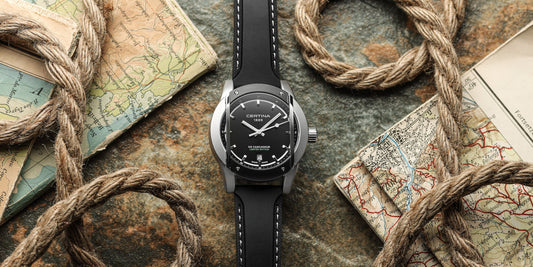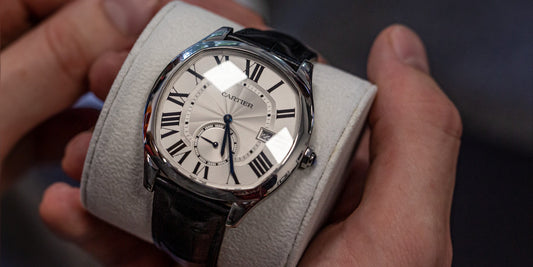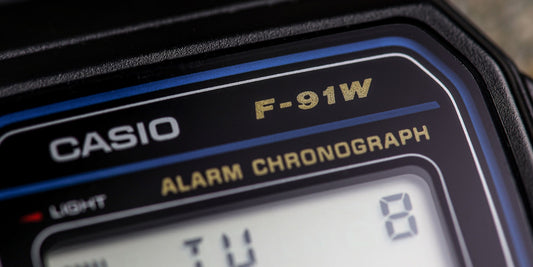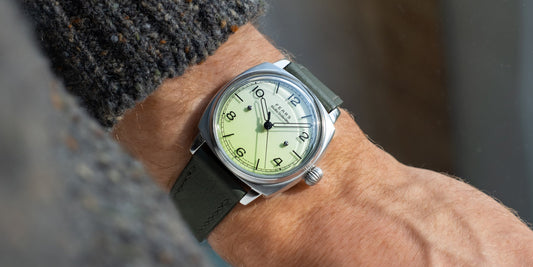For a brand more and more known for its collaborations than its core offering, Louis Erard impresses with this solo effort. Le Régulateur Gravé Noir is a sleek, stylish, sympathetically sized watch that veers very much in the dressier direction while retaining enough presence and subtlety to be worn on a daily basis. The watch packs a lot of punch given its modest 39 mm diameter, but its visual impact is enhanced by a couple of key elements that result in it being a watch that oozes confidence in its own design and worth.
Firstly, a slim bezel gives the dial an expansive feel. At 12.82 mm thick, the watch doesn’t suffer from “dinner plate syndrome”, which can be a good or a bad thing depending on how you feel about watches wearing true-to-size or not. The result is a watch that balances its visually engorging dial aperture with a hearty height on the wrist very nicely.
Secondly, the simple two-colour palette reduces the visual noise of the piece, and the complete absence of text creates a vintage “pre-power-brand-era” vibe.

Leaving one’s name and logo off the dial is absolute anathema for some designers, and while they have an easily defensible point in that regard, I personally love it when a brand has the cojones to rise above the clamouring need for attention exuded by its peers and simply create something beautiful without feeling the need to remind you at every opportunity who created it.
Although it’s a niche riposte to the many branding experts whose hair would be turning white at the thought, one could argue that the absence of a name on the dial is itself a conversation starter that would likely lead to a more in-depth discussion about Louis Erard and its wider activities.
This watch is what’s known as a “regulator”. A regulator dial gives the hours and the minutes (and in this case, the seconds as well) their own axis. Rather than the hour and minute hands being stacked atop one another, the hour hand occupies a sub-register at 12 o’clock, the minute hand has the central axis all to itself, and the going seconds hand occupies the six o’clock sub-dial.
I’ve always enjoyed regulator dials from a stylistic perspective. I adored the much-missed Tulloch T-01, and admire the Alpina Alpiner Extreme Regulator Automatic, believing it to be the most handsome watch in that entire Alpiner family. However, whether one finds a regulator easy-to-read will come down entirely to how you interpret the information presented on a watch dial.
If you instinctively read the hours first, followed by the minutes, for a mental readout that hits my ear as a more digital style (such as Two Forty for 02:40/14:40), then a regulator will probably work well for you as the eye naturally works its way from the top to the bottom of the dial.
On the other hand, it’s possible you are a “minutes-first” kind of person (like me) who looks at the minute hand before the hours and interprets the information more verbally than digitally, before checking the corresponding hour. For example, when I read the time, I ascertain where we are in whatever hour it is or is about to be first. If the minute hand is at the 20-minute mark, the first thing I see in my mind is “twenty past”. I then look for the hour to complete the sentence. To me, that feels a bit more like reading from left to right than doing it the other way round, but I concede I may be on an island there (let us know in the comments below).

One lovely design element that I’m sure most of us can enjoy regardless of how we read the time, is the sector dial decoration that adorns the six o’clock running seconds register. Louis Erard was founded in 1929, right around the peak of sector dial popularity, so this is a nice throwback to a quaint, but still influential period of design.
Theoretically, the sector dial was conceived to aid legibility. As such, I’m not sure the best place for it was the seconds dial (as I feel it is most effective when used in conjunction with the minute hand, splitting the hour into quarters), but given how much busier the design would’ve been if Louis Erard had chosen to slice up the vertical axis of the dial with a line that penetrated both sub-registers, I think the brand made the most elegant choice, even if it isn’t the most sensible from a time reading angle.
This piece is part of the Noirmont Metiers d’Art family, which means it’s one of the brands higher-end self-made pieces.
As the “Metiers d’Art” in the collection title might suggest, there is some fine artisanal handwork on display here. The dial markings are literally engraved into the dial surface and then plated with 5N rose gold.
One interesting thing to take note of in case you’ve already read (or plan to read) multiple reviews of this piece and have stumbled across our humble magazine during your research, is that many publications are simply describing the finish on the dial as “grained”.

In preparation for this article, I read several reports published by other titles and was repeatedly greeted with this term without any further clarification of what it actually meant. Normally, finishing terminology is relatively clear, but, upon seeing a lovely macro shot of the dial on aBlogtoWatch (an image that was either shot in-house or a press pack shot inexplicably omitted from the four articles I’d read prior to landing on ABTW) I realised that the term grained is being applied here in a way I wouldn’t naturally think to use it.
In my experience, graining, especially when used in reference to a dial finish, tends to indicate striated brushing. A “circular grain” would be a finish easily applied on a lathe, for example. Similarly, a “straight grain” would be the effect one achieves by dragging a material in one direction across an abrasive surface. Here, however, the “graining” referred to is a grainy finish that I would sooner describe as mottled, particulated, or simply textured. It is a roughened matte surface and provides an excellent contrast to the 5N rose gold plated engravings on the dial. A traditional “grained” finish, would itself catch the light and interfere with the legibility of the reflective engraving.
You could easily accuse me of skimming over the images and focusing on the text, but, in all honesty, had I trusted the text blindly without the assistance of that macro shot, I would’ve gone away expecting the piece to look very different in real life than it actually does.
At CHF 2,900, Louis Erard has once again succeeded in creating an excellent value for money piece that boasts a cavalcade of talking points. As we saw from the recent GPHG awards, this price segment of the industry is in fine fettle. This product proves once again that any up-and-comers hoping to unseat the established makers used to flexing the muscle of experience in the face of would-be challengers starting out with little know-how and fewer industry contacts, will have to work ten times as hard as before to compete in this hotly contested price bracket.
Overall, I find this release a satisfying one for a brand I often see as a little all over the map. The frequent collaborations are always fun, but regularly leave me more desirous of the pieces the brand’s collaborators have reimagined under the constraints of an entry-level luxury brand (for examples, think of the Konstantin Chaykin Cyclops and the recently unveiled Vianny Halter Régulateur).
Manuel Emch, the creative force behind Louis Erard is also one third of the team behind this year’s indie phenom, Kollokium. Kollokium’s first piece, which thoroughly deserved its place in the final six of the Challenge category at the GPHG (and was my pick to win), is roughly the same price. Is the Louis Erard better? Although, “better” is impossible to define cleanly, it is certainly different, and clearly pitches to a different, perhaps more conservative and mature demographic. And perhaps, given the brand’s almost-century-long history, and deep roots in the industry, its “safeness” can be understood.
Despite questioning how well it can hope to perform in a crowded market, I do very much like Le Régulateur Gravé Noir and believe it to be the best model by Louis Erard and Louis Erard alone for quite some time. If the vintage aesthetic mixed with modern manufacturing techniques and artisanal skill is your thing, I doubt this surprisingly versatile piece will disappoint.





















